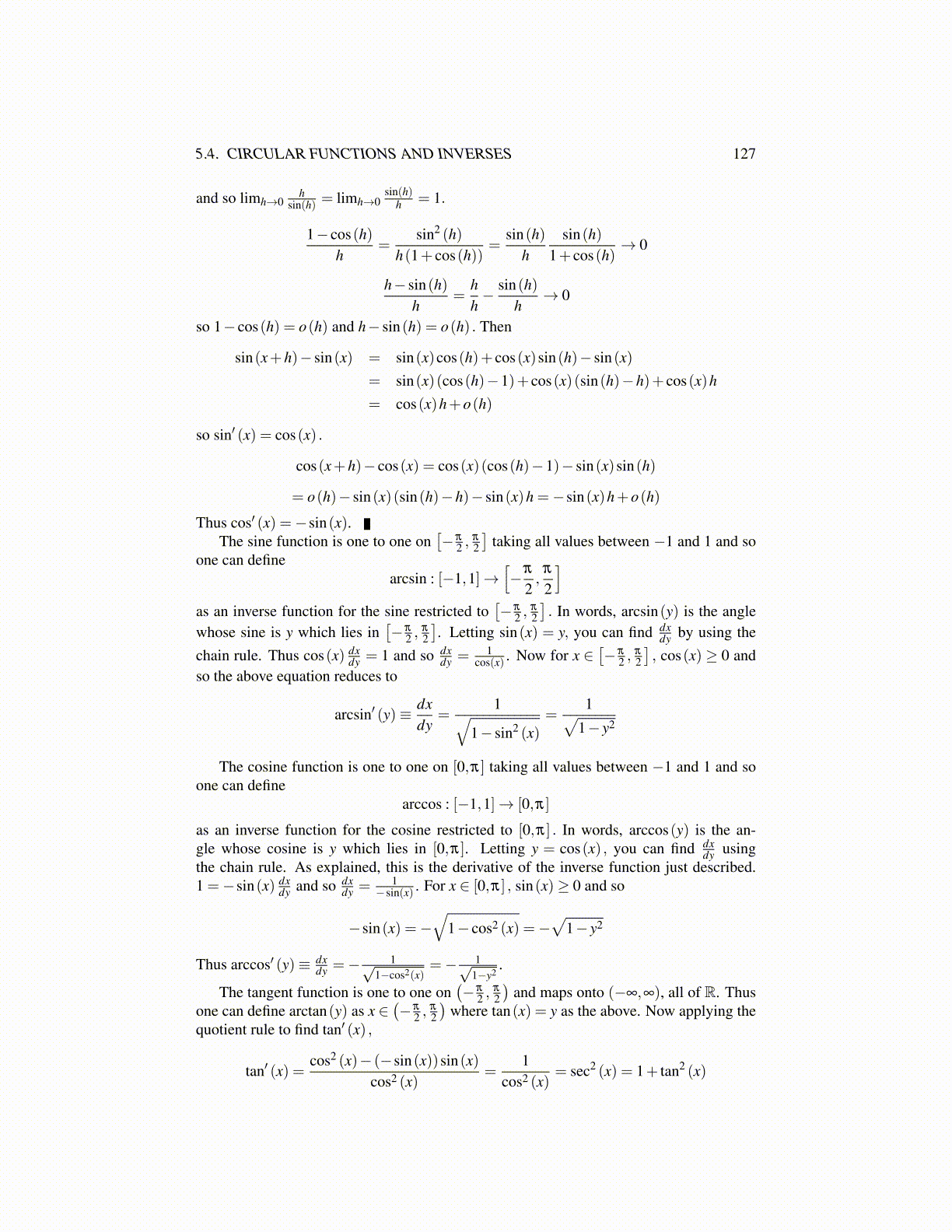
5.4. CIRCULAR FUNCTIONS AND INVERSES 127
and so limh→0h
sin(h) = limh→0sin(h)
h = 1.
1− cos(h)h
=sin2 (h)
h(1+ cos(h))=
sin(h)h
sin(h)1+ cos(h)
→ 0
h− sin(h)h
=hh− sin(h)
h→ 0
so 1− cos(h) = o(h) and h− sin(h) = o(h) . Then
sin(x+h)− sin(x) = sin(x)cos(h)+ cos(x)sin(h)− sin(x)= sin(x)(cos(h)−1)+ cos(x)(sin(h)−h)+ cos(x)h
= cos(x)h+o(h)
so sin′ (x) = cos(x) .
cos(x+h)− cos(x) = cos(x)(cos(h)−1)− sin(x)sin(h)
= o(h)− sin(x)(sin(h)−h)− sin(x)h =−sin(x)h+o(h)
Thus cos′ (x) =−sin(x).The sine function is one to one on
[−π
2 ,π
2
]taking all values between −1 and 1 and so
one can definearcsin : [−1,1]→
[−π
2,
π
2
]as an inverse function for the sine restricted to
[−π
2 ,π
2
]. In words, arcsin(y) is the angle
whose sine is y which lies in[−π
2 ,π
2
]. Letting sin(x) = y, you can find dx
dy by using thechain rule. Thus cos(x) dx
dy = 1 and so dxdy = 1
cos(x) . Now for x ∈[−π
2 ,π
2
], cos(x) ≥ 0 and
so the above equation reduces to
arcsin′ (y)≡ dxdy
=1√
1− sin2 (x)=
1√1− y2
The cosine function is one to one on [0,π] taking all values between −1 and 1 and soone can define
arccos : [−1,1]→ [0,π]
as an inverse function for the cosine restricted to [0,π] . In words, arccos(y) is the an-gle whose cosine is y which lies in [0,π]. Letting y = cos(x) , you can find dx
dy usingthe chain rule. As explained, this is the derivative of the inverse function just described.1 =−sin(x) dx
dy and so dxdy = 1
−sin(x) . For x ∈ [0,π] , sin(x)≥ 0 and so
−sin(x) =−√
1− cos2 (x) =−√
1− y2
Thus arccos′ (y)≡ dxdy =− 1√
1−cos2(x)=− 1√
1−y2.
The tangent function is one to one on(−π
2 ,π
2
)and maps onto (−∞,∞), all of R. Thus
one can define arctan(y) as x ∈(−π
2 ,π
2
)where tan(x) = y as the above. Now applying the
quotient rule to find tan′ (x) ,
tan′ (x) =cos2 (x)− (−sin(x))sin(x)
cos2 (x)=
1cos2 (x)
= sec2 (x) = 1+ tan2 (x)